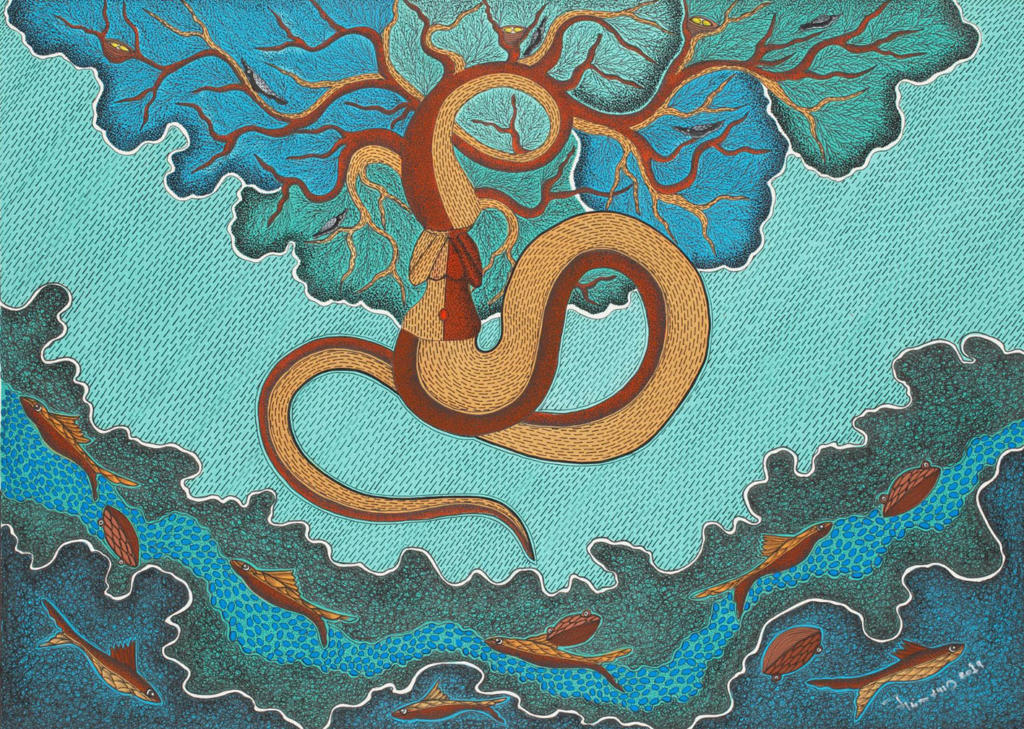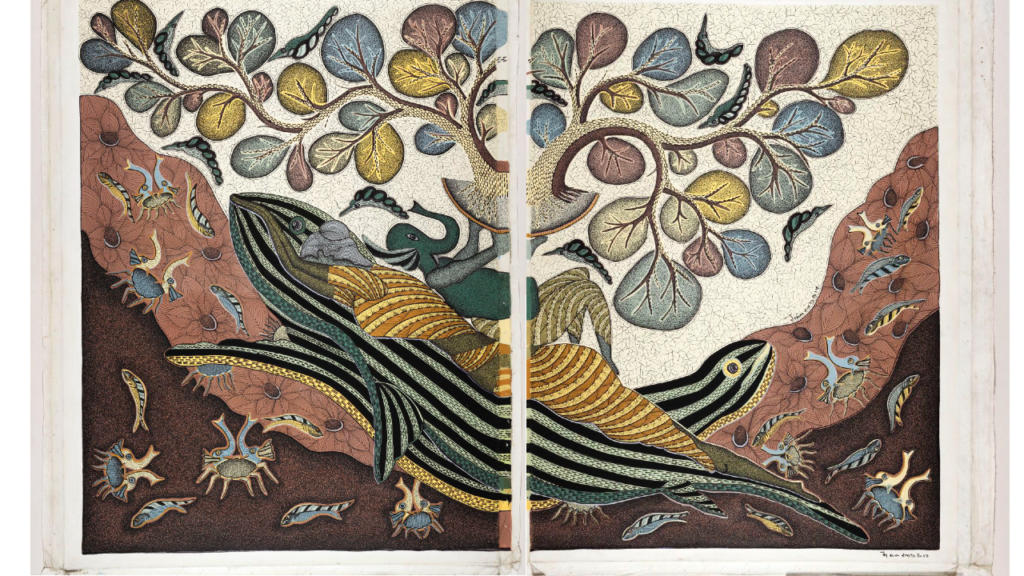
‘Milan’, acrylic and ink on paper, 2019, by Mayank Shyam © Sarmaya Arts Foundation
Milan was a part of our show Shifting Selves – Between meaning, mythology & mirage
“I do not guide my paintings, my paintings guide me,” says Mayank Shyam, an artist who is part-researcher and part-philosopher. “The canvas speaks to me, it tells me the shape it wishes to take and I oblige—it knows the form that would appear most striking, exactly the way a tree does. When we sow a seed, the tree does not ask us where its branches should go, it begins to take shape on its own without hesitation or boundaries. My paintings are completely and absolutely free.” Shyam makes this poetic revelation as he talks about a specific work, Milan. In this painting, a tree truck has been given a snake-like body and suspended in a terrain that’s in between water and soil yet embodies both. When asked how this shape came to him, the artist shares the credit with his tools and, in doing so, he gives his artistic process a spiritual meaning. This is just one of the many ways in which Mayank Shyam sets himself apart from his contemporaries.
Son of the legendary artists, Jangarh Singh Shyam and Nankusiya Bai, Mayank Shyam was born in 1987. He grew up steeped in the traditions of Gond art and the vocabulary of the contemporary art world. He remembers accompanying Jangarh Singh, the pioneer of Gond art, on his work and travels. Here he was exposed to a variety of creative influences, including theatre, that would later shape his art. “I didn’t set out to be different, I simply followed what my father always told me: ‘It isn’t necessary that you paint like me, you should paint whatever comes from your heart.’”
Shyam was only 14 years old when his father passed away in Tokyo, Japan where he had been invited for an exhibition project, and two years later, he began to paint professionally. “We (Mayank and his sister Japani) were very young when my father passed away so of course, we faced great difficulties. My mother felt completely alone and we didn’t have proper guidance on how to maneuver in the art world. So I went to the Crafts Museum in Delhi as an assistant to experience an exhibition for myself. A friend of my father’s Mr Acharya bought some of my works and remarked, ‘Mayank, your work is beautiful, you have your father’s genius.’ His appreciation became an incentive for me to start creating.” In this conversation with Sarmaya, Mayank Shyam elaborates on how he came to hone his unique vision of Gond art.
What would you say defines your art style?
“I never make paintings that are purely observational; every painting carries a philosophy, a message or a story. For instance, in my early years as an artist I visited Mumbai and for the first time experienced a macro city—the crowd, the tall buildings, the pace. At that time, I painted a canvas full of buildings. But it wasn’t just a painting of buildings, it carried a very interesting pattern of behaviour of the city folk inside it. During my time in Mumbai, I came to know that many rich people leave the city when the summer months begin and come back only when it has cooled down. My painting showcased a plane and a bird alongside it to shed light on the migrations taking place in the city. The bird, of course, follows the same pattern and I found this similarity fascinating.

Untitled painting by Mayank Shyam © Sarmaya Arts Foundation
“It was around this time, about 10 years ago, when I was trying to understand what kind of work I like. What do I want to make? This is when I started creating works that carried my perspective, my own pattern and even colours used in a new way. My style really came from this deep introspection. Many people criticised my art in the beginning saying, ‘It isn’t Gond art’, ‘It doesn’t carry the traditional patterns’. And it happened simply because I was a second-generation artist, my father came from the village and was looking towards the city while creating art, while I was born in a city and I’m looking towards my village. Being born in Bhopal I was introduced to many more things right from the start and the work I create is a fusion of all my interests.”

‘Kakai Kata’ by Mayank Shyam © Sarmaya Arts Foundation
What is the story behind Kakai Kata?
“It’s about the relationship between old and new; old myths are still relevant to our realities today. A lot of my recent work is aligned with this broad statement. Kakai Kata is a Gond folk story told to me by my father, my neighbours and my relatives on separate occasions. The story goes like this: While his father Lord Shiva was away, Lord Ganesha was guarding the cave in Kailash Parbat that housed his mother, Goddess Parvati. But his mother in turn was anxious about her son’s safety, so she planted the kakai kata or green pumpkin plant 10 steps ahead of Ganesha for his protection. Anybody coming for her son would be trapped by its thorns.
“I found this very interesting so I started researching the story and its origins. I found that even today, the roots of the kakai kata are given to women during pregnancy. Its high nutritive value is said to protect the child inside the womb. The similarity of the nature of the tree as a protector in myth and in reality compelled me to paint this story. The tree of Kakai Kata in this painting takes an imaginative form on and under which Goddess Parvati and Lord Ganesha rest.”
In the backdrop of the painting, you have painted soil but the soil contains fish and crabs as if it were a waterbody and the Kakai Kata shape suggests that it too is swimming in the soil. What does this signify?
“Yes! In all my paintings I invoke the presence of Bada Dev, it doesn’t matter what the story is, what the concept is, he is ever-present. I see Bada Dev everywhere in my reality and this is why most of my work is based on trees and water. The story of Bada Dev is the story of how the universe was made. Our deity was formless but he took something resembling the human form to create life on earth. He realised that earth was only made up of water, so with his hair he created a source of sustenance in the form of trees and with his throat he created the Pradhan jaati, which is our tribe. Once he created the soil, trees and humans, he returned to being formless, remaining on earth only as shakti. Today, our community celebrates his presence during the festival of Hariyali, which happens at the beginning of the monsoons. When all life is desperately waiting for water and food, rains once again bring creatures to life. I love the monsoon season and I found out a couple of years ago that my father loved it too.”
The colours that you have used in your paintings are so striking. In Milan, the different tones of blue and in Kakai Kata the muddy green and deep brown form a a subtler palette. What inspires these colours?
“Again, it comes from the story of Bada Dev, the part when he is creating the soil and ground for humans to walk on. When the soil is brought to him by kekda-ji or the crab, it possesses such brilliant and varied colours like brown, black, red, muddy green, white and yellow. The colour of soil is different in different countries and continents. Even when it appears to be one uniform colour, if you really look you will realise it carries so many different elements and minerals, all ground together by the atmosphere into fine pieces. So my colours are inspired by the earth that you and I live in.”
What message or emotion do you wish to leave with viewers of your art?
“I make my paintings for nobody but myself. All artists will agree with me when I say that a painting has to impact the artist first, it has to appease me before it impacts an audience. I have so many paintings that I worked so hard on but never displayed because I was unsatisfied with my research or my aesthetic. Sometimes I may even realise that the painting wasn’t given freedom by my hands, I was too narrow in my approach. Then I have to discard it. I pick up a new canvas and start painting the same story with a different take again, trying to reach the freedom it was missing.

Untitled painting by Mayank Shyam © Sarmaya Arts Foundation
“The first step in my process is my vision, my imagination, my ideas on what forms I could give these elements. Sometimes when I sketch what is in my mind it comes out better than I thought and that’s when I start working on taking it further. After that, I start thinking about the colours and that’s when I am unable to sleep. I just want to get up early and finish the colouring and see the final work. I forget food, water, everything because I become obsessed with the painting. Truly, I believe I paint for myself.”



